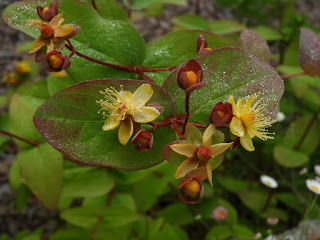A native plant of the Scrophulariaceae or Figwort family, Harrap's Wild Flowers says it's fairly common. I've seen three small sites of it within a 5 mile radius in my part of the Lower Wye Valley. As with most native plants it has a range of local names including Stinking Roger in Cheshire referring to its smell but its healing qualities seem recorded in Cut-finger in Surrey and Poor Man's Salve in Devon. Grigson in An Englishman's Flora calls it ugly- with which I would disagree- but also records the name Fairies' Beds in Dorset. It long persisted in folk medicine for ulcers, worms, cancer, the itch and red faces.
It grows in damp woodland and is very like Water Figwort but @AngelikaHTCG has a good tip for telling them apart: the stems of Water Figwort look as though they have been pinched for extra sharp edges on the wings. Common Figwort stems are not winged or only slightly so.
@Barbus59 offers advice on the leaves of Water Figwort which have rounded bases and little ears at base. The leaves of Common are squared off and nettle like.
Thank you both! The Twitter wildflower community is always very helpful.
Hogweed, Heracleum sphondylium
It was used as a food for pigs hence the name but it was also known as Cow Parsnip. The scientific name is worth a note. It was named for Heracles because of its height, to 180cm in summer sometimes more. (NB Giant Hogweed is the huge one, up to 6m and an introduction, not native.) Linnaeus described it in 1753 using the term sphondylium meaning vertebrate and referring to the shape of the segmented stem.
Slender St John's-wort, Hypericum pulchrum
I saw this on the heathland bordering Cleddon Bog where it is locally common. Delicate and attractive it has reddish buds because the yellow petals are tinged red below. The main ID feature is the leaves: oval, blunt at the tip and with a heart shaped stem-clasping base. They can just be seen here.
Tutsan, Hypericum androsaemum
This member of the Hypericaceae family, also a native, is much more familiar. This one is in my garden and is one of half a dozen or so that have self-seeded or been bird-seeded here. Leaves oval, the petals are equal to or shorter than sepals. It has black berries in the Autumn which give rise to one of its folk names in Cornwall: Devil's Berries. Most of the names come from the south-west where the plant is very frequent. As so often the plant has a good reputation too. The leaves were applied to grazes and wounds. The dried leaves were put between the pages of prayer books and bibles.
Four plants, three plant families, attendant folklore and history. I hope you have found it interesting. More in #Wildflowerhour at the weekend.





No comments:
Post a Comment